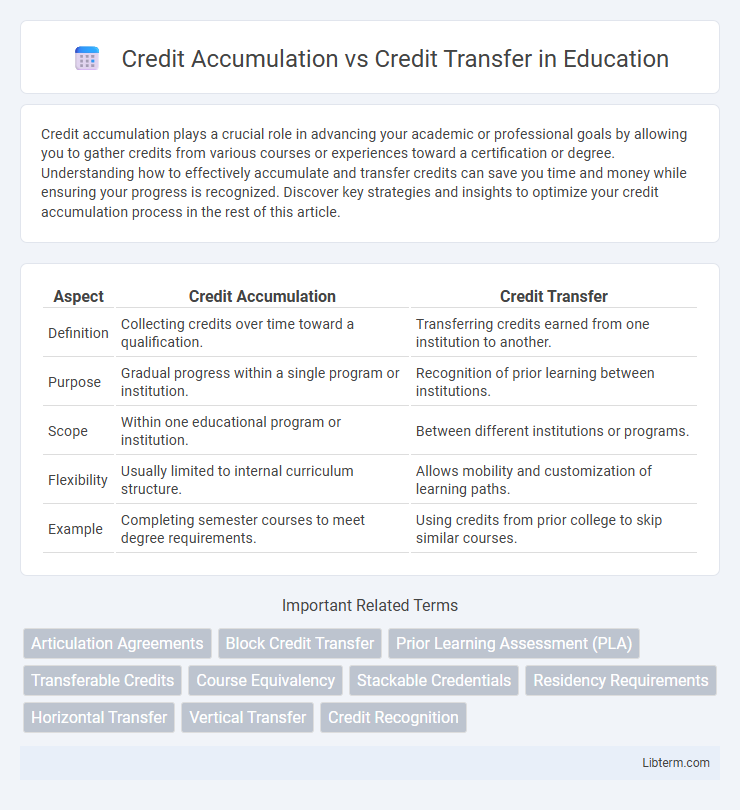Credit accumulation plays a crucial role in advancing your academic or professional goals by allowing you to gather credits from various courses or experiences toward a certification or degree. Understanding how to effectively accumulate and transfer credits can save you time and money while ensuring your progress is recognized. Discover key strategies and insights to optimize your credit accumulation process in the rest of this article.
Table of Comparison
| Aspect | Credit Accumulation | Credit Transfer |
|---|---|---|
| Definition | Collecting credits over time toward a qualification. | Transferring credits earned from one institution to another. |
| Purpose | Gradual progress within a single program or institution. | Recognition of prior learning between institutions. |
| Scope | Within one educational program or institution. | Between different institutions or programs. |
| Flexibility | Usually limited to internal curriculum structure. | Allows mobility and customization of learning paths. |
| Example | Completing semester courses to meet degree requirements. | Using credits from prior college to skip similar courses. |
Understanding Credit Accumulation
Credit accumulation involves systematically earning and storing academic credits over time to fulfill degree requirements, enhancing flexibility in educational pathways. This process allows students to gather credits from multiple courses or institutions, facilitating lifelong learning and skill development. Understanding credit accumulation is crucial for managing academic progress and planning transfers or further education efficiently.
What is Credit Transfer?
Credit transfer is the process through which academic credits earned at one educational institution are recognized and accepted by another institution, allowing students to continue their studies without repeating equivalent coursework. This system facilitates student mobility by enabling seamless progression between programs or universities, often formalized through articulation agreements or transfer policies. Effective credit transfer relies on evaluating course content, learning outcomes, and accreditation standards to ensure compatibility and maintain academic quality.
Key Differences Between Credit Accumulation and Credit Transfer
Credit accumulation involves earning and collecting credits over time within a single academic program, allowing students to progress toward a qualification by completing required modules. Credit transfer permits students to apply previously earned credits from one institution or program toward another, facilitating academic mobility and recognition of prior learning. Key differences include accumulation being a process within one program, whereas transfer enables credit recognition across different programs or institutions, impacting degree completion timelines and credit validity.
Benefits of Credit Accumulation
Credit accumulation allows students to progressively build a portfolio of earned credits over time, providing flexible pathways toward degree completion without the need for immediate full transfer. This approach supports personalized learning by enabling credit recognition from diverse courses and institutions, enhancing academic mobility and lifelong learning opportunities. By accumulating credits, learners can optimize their educational journey with incremental milestones that align with their career goals and schedules.
Advantages of Credit Transfer
Credit transfer enables students to apply previously earned academic credits toward a new degree program, reducing time to graduation and overall education costs. This system enhances academic flexibility by allowing seamless transitions between institutions and programs, ensuring that prior learning is recognized and valued. It also fosters increased opportunities for international study and professional mobility by standardizing credit recognition across different educational frameworks.
Challenges Faced in Credit Accumulation
Credit accumulation presents significant challenges such as inconsistent credit recognition across institutions, leading to difficulties in standardizing learning outcomes and credit values. Students often face barriers due to diverse curriculum frameworks and lack of transparent credit transfer policies, which hinder the seamless aggregation of earned credits. Administrative complexities and inadequate digital infrastructure further complicate tracking and validating accumulated credits for academic progression.
Common Issues in Credit Transfer
Credit transfer often faces issues such as discrepancies in curriculum content, varying credit valuation systems, and lack of standardized evaluation criteria between institutions. These challenges can result in partial or non-recognition of transferred credits, delaying student progress and increasing educational costs. Ensuring transparent articulation agreements and robust credit mapping protocols enhances the reliability and fairness of credit transfer processes.
Role of Credit Systems in Higher Education
Credit systems in higher education play a crucial role in facilitating student mobility and academic progression through credit accumulation and credit transfer mechanisms. Credit accumulation allows students to complete course modules over time, building towards a qualification, while credit transfer enables the recognition of previously earned credits across different institutions or programs, reducing redundancy and accelerating degree completion. Effective credit systems promote lifelong learning, flexibility, and internationalization within higher education frameworks.
Strategies for Effective Credit Management
Strategies for effective credit management emphasize distinguishing between credit accumulation, where students earn credits from multiple courses over time, and credit transfer, which involves moving earned credits between institutions. Implementing clear policies to evaluate and validate transferred credits ensures academic progression without redundancy. Utilizing digital credit tracking systems enhances transparency and helps students strategically plan their course load to maximize credit efficiency.
Future Trends in Credit Accumulation and Transfer
Emerging trends in credit accumulation emphasize personalized learning pathways supported by artificial intelligence, enabling students to accumulate credits through diverse, non-traditional educational experiences such as micro-credentials and online modules. Credit transfer is increasingly facilitated by blockchain technology, ensuring secure, transparent, and instant verification of academic records across institutions globally. Institutions are also adopting standardized credit frameworks and international agreements to simplify credit mobility and promote lifelong learning in a rapidly evolving educational landscape.
Credit Accumulation Infographic

 libterm.com
libterm.com